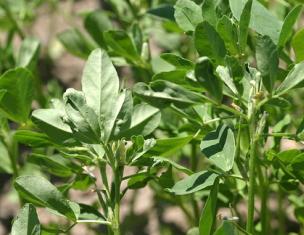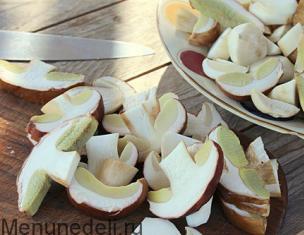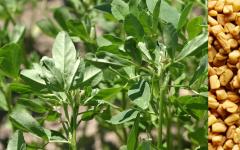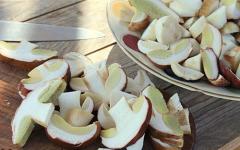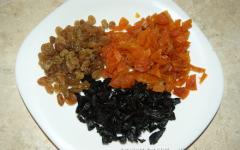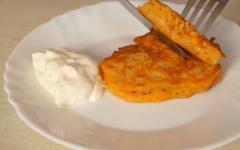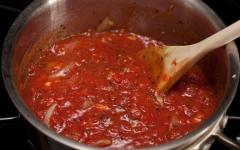Mushrooms must be just picked (fresh), strong and not wormy - for this they must be carefully sorted and cleaned of forest debris (moss, pine needles, leaves, sand).
Next, the mushrooms need to be sorted by size - large caps cut into slices; the legs, if they are thick - in round shapes, if not very thick - then just columns will be enough. The thickness of the cut pieces is approximately half a centimeter.
By the way, to avoid darkening of the cuts on mushrooms, it is recommended to use a stainless steel knife.

Place the prepared mushroom slices on baking sheets lined with baking paper. They should be laid out in one layer so that they do not touch each other.
Place the baking sheets in the oven, heated to 50 degrees, for 1 hour with the door ajar (for better air circulation). In general, they advise starting at 45 degrees, but, for example, in my oven the minimum heat is set at 50.
During this time, the mushrooms will have dried a little and will no longer be sticky.
Then you can increase the temperature to 75-80 degrees and leave it to dry further, with the door still ajar.

How long to dry mushrooms? It is impossible to answer this question with certainty; we will have to find out as we go along. Here everything depends on the initial moisture content of the mushrooms (picked in dry or wet weather), and on the size of the cut, and on the density... You just have to periodically remove the baking sheets from the oven and check them.
Remove already dried mushrooms for storage, and turn the rest over and send them for drying.
A properly dried mushroom should be dense, elastic and slightly bendable, not crumble or break. An undried mushroom is still soft, as if rubbery.

You can store whole dried mushrooms in glass or metal, tightly sealed jars; linen bags or paper bags.
It is important that the storage area is dry and well ventilated. Strongly smelling foods (garlic or onions) should not be stored nearby; mushrooms can easily absorb their smell and moisture.
Well, the mushrooms themselves should be checked periodically so that they do not become damp in any way. In this case, they must be immediately sorted out, damaged ones removed (if any are found) and dried again.
By the way, dried mushrooms can also be frozen - this way they will last longer.
Before cooking, dried mushrooms must first be soaked in cold water for 1-2 hours. Don’t throw away the water in which they were soaked - this is a wonderful mushroom broth!

Well, if your mushrooms have dried out and become too brittle, then you can make mushroom powder from them. It can be added to any dishes (sauces, gravies, soups...) for a richer and richer taste, because mushroom powder completely preserves the taste and aroma of mushrooms.
To do this, just using a coffee grinder, dry mushroom plates are crushed to a powdery state.
If desired, you can add spices to this mushroom powder - salt, pepper, nutmeg - a great replacement for store-bought bouillon cubes!

Dried mushrooms have high nutritional value, rich aroma and taste, and perfectly retain their beneficial properties. Using an electric dryer, you can make a good supply of mushrooms for the winter, spending very little time on it.
To get a quality product, you need to know which mushrooms are suitable for drying, how to properly prepare and dry them, and, of course, how to store them correctly.
Almost all edible mushrooms can be dried, but it is still better to use tubular types for this:
- white;
- boletus;
- boletus;
- boletus;
- flywheels.
When dried, these mushrooms have a very pronounced taste, which cannot be said about the lamellar types. After drying, saffron milk caps or russula, honey mushrooms and chanterelles acquire a slight bitterness, which is quite difficult to get rid of. Dried marsupial species such as white truffles and morels have a very good taste. It should be borne in mind that when dried, mushrooms significantly lose weight, so the output is no more than 10% of the original volume.

Proper preparation
Mushrooms for drying must be freshly picked, without wormholes or rot. Old mushrooms with a dried out cap or wrinkled mushrooms should not be collected, much less dried. It is also not recommended to wash them before drying - this will prolong the drying time and worsen the taste of the finished product. It is enough to remove leaves, remaining soil and other debris from the mushrooms, and trim the damaged areas with a knife. To prevent the surface from darkening when cutting, the knife should be made of stainless steel.
Whole mushrooms are dried only in air, but for the oven or electric dryer they need to be cut into small flat pieces. The boletus stem is not suitable for drying, so it is cut off right up to the cap; For boletuses and porcini mushrooms, only the bottom of the stem is removed, everything else is dried. Small mushrooms can be left whole or cut in half, but large ones should preferably be divided lengthwise into four to five parts, the thickness of which should not exceed 10 millimeters.

Drying process
An electric dryer is the best option for harvesting forest products. Thanks to a well-thought-out design, drying mushrooms takes little time and does not require constant presence and control. Having set the required temperature and time, you can go about your business while the equipment is working. So, each tier of the electric dryer is filled with chopped mushrooms in one layer, the pieces are straightened and leveled. Set the temperature to 55°C, time - from 2 to 6 hours.
The thinner the plates are cut, the less time it takes to dry the mushrooms in an electric dryer. To speed up the process, you can periodically swap the pallets. It should be borne in mind that a small amount of cuttings dries much faster, so if you put two or three trays in the electric dryer, and not all five or six, you need to check the readiness after two hours, otherwise you can overdry the contents.
It is not difficult to determine the degree of readiness of the forest products: if the pieces spring slightly when bent, do not break, and look completely dry, the electric dryer can be turned off. If the plates bend very easily and look a little damp, they still need to be dried. Mushrooms that are overexposed become very hard, darken, and may fall apart. They are not suitable for cooking, but they are suitable for preparing mushroom powder: grind the dried pieces in a coffee grinder, add 10% regular salt and mix thoroughly. The resulting mixture is poured into a glass container and closed tightly.
Storage rules
It is known that mushrooms easily absorb foreign odors; improper storage can completely ruin this product. So, after drying, the mushrooms need to be cooled to room temperature and placed in glass jars or thick cardboard boxes. The room where they are stored must be dry and ventilated. The permissible air humidity is 70%; in more humid rooms, the workpieces will mold.
Instead of cardboard boxes, you can use gauze bags for storage, hanging them from racks or hooks on the wall. Periodically, dried mushrooms need to be sorted, discarding rotten or moldy pieces. As a rule, they are stored for no more than a year, then the taste decreases and the aroma fades.
Dried mushrooms, as opposed to pickled or salted, have natural taste and aroma. They are added to first and second courses, sauces, pie fillings or salads. Mushroom powder, which is used as a seasoning, is very popular.
In some cases, dried “gifts of the forest” are even tastier and healthier than fresh ones. For example, they contain more plant protein, which is nutritionally superior to animal protein. In addition, such mushrooms are easier to digest, therefore they are considered dietary. For any dish they will be required 6–8 times less in volume than that allows you to store the product economically.
It is dried mushrooms that make our soups or broths incredibly flavorful. The product has healing properties:
- It is believed that dried porcini mushrooms have a pronounced antitumor effect. They also enhance metabolism, normalize the gastrointestinal tract and improve blood composition.
- Honey mushrooms help with intestinal atony.
- Butter is recommended for gout.
- Boletus and boletus protect against atherosclerosis.
- Chanterelles remove toxins from the body, including radionuclides, cleanse the liver, and fight tuberculosis and hepatitis.
Not all mushrooms are suitable for drying. During the process of dehydration, the taste of the product intensifies and becomes brighter. And if some species are only slightly bitter when fresh, when dried they will simply be unsuitable for food. 
What mushrooms can be dried for the winter?
For clarity, we present the following table:
| Type of mushrooms, depending on structure | Characteristic | Kinds |
| Tubular | The lower part of the cap (hymenophore) consists of numerous vertical tubes tightly pressed together, in which spores are stored. At first glance, this surface resembles a porous sponge. | White mushroom (boletus) Mokhoviki boletus Boletus Polish mushroom |
| Lamellar | In this category, the hymenophore is a plate radiating radially from the stalk. When the cap is broken, milky juice often appears on the pulp. | Honey mushrooms Champignon Deer mushroom (Pluteus deer) Polypores: winter, sulfur-yellow, umbrella and scaly |
| Marsupials (ascomycetes) | They have an irregular shape and are divided into small sections (bags) where the spores are stored. | White truffle |
| Chanterelle family | It seems that the hymenophore in such mushrooms consists of plates, but in fact these are folds of the fruiting body. The peculiarity of the structure of chanterelles forced biologists to distinguish them into a special family. | Chanterelle: ordinary, faceted, cinnabar red, velvety |
Tubular mushrooms
All representatives of this category can be dried in any available way:
- on air
- in the oven or microwave
- in an electric dryer
The white mushroom is especially popular among housewives, which has long received an unspoken secret for its unsurpassed aroma and beneficial properties. title of "king of the forest".
It is better to dry boletus mushrooms and then cook them separately, since they produce a very beautiful, clear broth. Other types of mushrooms can make the liquid in which they are cooked cloudy, or even color it dark.
Dried boletus and boletus are also distinguished by high nutritional qualities, but during the process of dehydration they turn black, which not everyone likes.
Duboviki and Polish mushroom will delight pronounced “mushroom” smell and pleasant taste.
Butter and goats are dried much less often, and if they are prepared in this way, they are used as a seasoning - they crumble a lot.
Lamellar mushrooms
It is more difficult with lamellar mushrooms. Many of them are more suitable for salting and pickling, fully revealing their characteristic spicy taste when preserved. If such a product is dried, it will be, at best, bland, and at worst, it will begin to become noticeably bitter. 
However, there are also suitable options:
- Champignon
- colorful umbrellas
- honey mushrooms
- oyster mushrooms
- deer spittle
Polypores are also dried, but mainly for medicinal purposes.
Ascomycetes
Among marsupial mushrooms, only morels deserve attention. It is unlikely that the average housewife will prepare a delicious truffle for future use. And the lines, although considered conditionally edible, contain strong toxins - gyromitrins, which negatively affect the blood, liver and gastrointestinal tract. If cooked incorrectly, exposure to them can be fatal.
Morels appear in our forests in the spring, when the main “quiet hunting” season is still far away. Not all housewives decide to collect these mushrooms, since handling them requires certain skills.
Helvelic acid, which is classified as a poison, was found in morels. You can remove it by soaking the product in water, and then boiling it in several stages, at each of which the liquid is drained.
If there is a large harvest of morels, it is worth storing them for future use by drying them in the oven or in the open air. If the first method is chosen, the product can be consumed 90 days after treatment. Morels are dried naturally for at least 2 - 3 months, it is believed that during this period toxic substances completely evaporate from them.
Chanterelles
Of the entire extensive family, only the common chanterelle is suitable for drying. Moreover, cute light orange mushrooms are recognized as the most useful when dried. 
The only downside of chanterelles is their slightly bitter taste. It will be less noticeable if the product is dried in an oven rather than in the open air.
What mushrooms should not be dried?
All varieties of “forest gifts” that secrete bitter milky juice are unsuitable. Among them:
- milk mushrooms
- waves
- loading
- valuei
- russula
Most russula will taste bitter, so it’s not worth the risk.
As for saffron milk caps, the issue is controversial. They do not have such a pungent taste as milk mushrooms or valui, but some bitterness, like most lamellar ones, will still be noticeable. Whether to dry saffron milk caps, each housewife decides individually - this is a matter of personal taste preference, but direct There are no contraindications in this case.
Mushrooms of the species Coprinus (dung beetles) are rarely eaten. However, they have many beneficial properties. Dung beetles are subject to autolysis—some time after collection, they self-dissolve if they are not immediately processed. The product is dried, but not in the usual way, but in a frying pan, evaporating the liquid for 45 - 60 minutes. It is then ground into powder and stored that way.
In conclusion, we note that you can and should dry mushrooms, since this is the safest way to prepare them. And to avoid problems, you need to carefully select a product. You should pay attention not only to the variety of mushrooms, but also to their condition, immediately discarding old or wormy specimens. In addition, during a “silent hunt” it is better to avoid “prey” that is questionable, and in the market buy the product exclusively from trusted sellers.
It is important, then they will bring us only benefit and pleasure. 
If you find an error, please highlight a piece of text and click Ctrl+Enter.
Kira Stoletova
Boletus is one of the most valuable mushrooms; it has a special taste and refined aroma. When fresh, this product cannot be stored for long. It is not only salted and pickled, but also dried. If boletus mushrooms are dried, they will not only be as good as porcini mushrooms in terms of taste, but will also be able to compete with them.

Features of boletus
They grow in deciduous forests, mainly in sunny meadows. They are collected at the end of spring.
Kinds
There are several types of boletus:
- Ordinary: it is fried, dried or pickled.
- Black: its cap is dark brown or black, slightly smaller than the usual one. It is recommended to collect them from the second decade of summer until September. They grow near swamps. They are allowed to be eaten, but they are not popular due to the porous structure of the pulp.
- Bolotny: grows near swamps and in the mosses of mixed forests. It has a very light, whitish or pale brown cap. Taste qualities are inferior to ordinary boletus. Its flesh is white or greenish, watery.
- Pinkish: This mushroom has a gray or dark brown convex cap, reaching 15 cm in diameter. The flesh is dense, the stem turns a little pink when cut.
The most popular of them is the common boletus. Its wide cap reaches 15 cm. The color ranges from gray and light brown to dark brown. The flesh of the mushroom is dense. It can be confused with a poisonous gall mushroom. It is easy to distinguish them: inedible specimens have a pinkish cap inside (hymenophore), and the cut stem darkens in air.
Preparing for drying
Drying is one of the simplest, most accessible and common methods of processing mushrooms. During the process, the mass of the product is reduced by 10 times.
The dried product is stored for a long time and acquires unusual taste and aromatic qualities. Before you start drying, you need to prepare the mushrooms: remove any adhering grass, leaves and remaining soil. Specimens eaten by worms are thrown away. There is no need to wash them, because... The tubular hymenophore, like a sponge, very actively absorbs water, as a result of which it will not be possible to properly dry the collected mushrooms. The mushrooms need to be sorted and distributed by size. Large ones are cut into equal pieces. If the caps are dirty, they are cleaned with a sponge and the skin is removed from the stem.
Drying
There are several ways to dry fresh boletus at home:
- on air;
- in a Russian stove;
- in the oven;
- in a dryer for vegetables and fruits;
- in an air fryer.
The main thing in drying boletus mushrooms is to start gradually. The fruiting bodies should dry out and not cook. Do not slow down the drying too much, otherwise the product will deteriorate.
On the street

This method is used if the weather is good. To do this, pallets with lattice bottoms are built right on the street.
Products are placed on a stand. They are strung on rods and placed in a horizontal position, leaving a gap between them. Turn the mushrooms regularly so that they dry on all sides.
Drying lasts 2-3 days. Another way to air-dry mushrooms is to thread them on a strong thread and hang them outside where a light breeze will blow over them. To protect mushrooms from insects and dust, they must be wrapped in gauze. It is recommended to finish the process in the stove or oven.
In the Russian stove
Drying boletus mushrooms in this way is very simple. The main thing is to adjust the heating. To make sure that the temperature is appropriate, you need to throw a sheet of paper into the oven; if it does not ignite immediately, the mushrooms are sent inside. Dry them in an oven on iron grates for 10 to 12 hours.
Irina Selyutina (Biologist):
In the sections of culinary publications of the USSR of the 50-60s. 20th century, devoted to the subject of mushroom harvesting, the principles of drying mushrooms in a Russian oven, based on practically real data, were indicated:
- acceptable temperature;
- trays with mushrooms are placed on bricks placed under their edges;
- creating good air circulation when the stove damper is slightly opened.
Since mushrooms dry unevenly, using a Russian stove you will have to constantly monitor the drying process, removing small ones that are already dry and leaving larger ones for drying.
In the oven
In the oven the process also happens quite quickly. It will take a lot of baking trays. Prepared mushrooms should be cut into small pieces and placed on a dry baking sheet, having previously covered it with baking paper (prevent sticking to the surface of the baking sheet). Next, the iron sheet is placed in an oven preheated to 45-50 °C. When the food has dried and stops sticking to the parchment, raise the temperature to 70°C. When dried in an oven, 10 kg of fresh boletus mushrooms will yield 1-1.5 kg of product. Attention! When using this option for drying boletus mushrooms, do not forget to keep the oven door ajar, because... this will ensure the necessary air circulation and prevent the mushrooms from cooking. Drying mushrooms lasts 2 days with breaks for cooling and airing them outside the oven.
In the dryer for vegetables and fruits
The products are cut (preferably into slices) and placed in a drying container. The “Mushrooms” mode is turned on with a temperature of 65 °C. During the drying period, the device must be turned off several times so that the boletus mushrooms cool down and the moisture in them is distributed equally throughout the entire cut. The trays should be swapped periodically so that all the mushrooms dry evenly.
In a convection oven
The fruiting bodies are cleaned and wiped with a damp nylon cloth. Next, they are sorted by size, cut into slices and placed on a wire rack. A small gap must be left under the convection oven lid to allow excess moisture to evaporate. Drying lasts one and a half hours at a temperature of 90 ° C.
Rules for drying mushrooms. Boletus mushrooms.
Dishes made from these mushrooms are aromatic and extremely tasty.
The boletus is rightfully considered one of the most valuable mushrooms. It has a unique taste and refined aroma. Dishes prepared from this product will not leave even avid gourmets indifferent. But these mushrooms cannot be stored fresh for a long time. But I really want to enjoy them all winter. Therefore, many people wonder how to dry boletus mushrooms. This can be done in the oven, electric dryer or outdoors. Dried mushrooms can be an excellent base for a wide variety of dishes.
You can find boletus mushrooms in deciduous forests. They feel best in the shade of birch trees. Look for them in sunny areas. This is due to the fact that the mycelium needs to warm up well. You can begin quiet hunting for this species as early as the end of May.
There are several types of boletus: common, pinkish, black and swamp. The most popular is the common boletus. It has a large cap that can reach 15 cm in diameter. The color of the cap can vary from light to dark brown. The pulp is quite dense. Its color does not change in air.
In appearance, boletus mushrooms are similar to gall mushrooms, which are poisonous. Eating them can be hazardous to health, so before putting the mushroom you find in your basket, carefully inspect it. The inside of the cap of poisonous specimens has a pink tint. If you cut off the stem of a gall mushroom, it will immediately begin to darken in the air.
How to prepare boletus mushrooms for drying?
Only fresh mushrooms are suitable for drying. Therefore, it is necessary to begin their processing on the day of collection. First of all, remove large debris and inspect them carefully. Specimens that show wormholes or signs of rotting are not suitable for drying. You should also throw away specimens that are too old, the cap of which has already begun to wrinkle.
There is no need to wash mushrooms before drying. This will only increase their cooking time. It is enough to simply remove debris from them using a soft brush or a piece of soft cotton cloth. If the contamination is so strong that it cannot be removed using this method, then it is best to simply cut off this area of the mushroom. All damaged areas must also be removed using a sharp knife. The stems of boletus mushrooms are unsuitable for drying, so they need to be cut off.
Drying in an electric dryer
If you need to process a fairly large number of boletus mushrooms in a short time, then it is better to use an electric dryer. The design of this device allows you to dry mushrooms without any effort.
First of all, mushrooms prepared for drying must be cut. Turn boletus into thin slices. Moreover, the thinner the slices you get, the less time it will take to dry them. Place boletus mushrooms on the trays of the device.
All that remains is to set the required temperature and time on the dryer. For boletus mushrooms, the best temperature is 550C. The process will take from two to six hours. If you want to speed up drying, you need to change the trays from time to time.
Determining the readiness of boletus mushrooms is quite simple. Bend the piece, if it springs slightly and does not break, then the device can be turned on. If you can easily bend the slice, then drying must be continued. Excessive hardness and darkening of the mushroom will indicate that you have dried it out. Such boletus mushrooms are unsuitable for subsequent cooking. But you can make mushroom powder from them. To do this, simply grind them using a coffee grinder.
Air drying
Drying boletus mushrooms in the open air is the least energy-consuming. It does not require any special devices. But compared to other methods, for example, oven drying, this method takes the most time. Typically, this process takes at least seven days.

Properly prepared boletus caps must be strung on a thick thread or thin fishing line. In this case, it is necessary to ensure that the mushrooms do not come into contact with each other. Hang this thread in a well-ventilated place. To prevent insects from landing on boletus mushrooms, cover them with a clean piece of gauze.
You can use another option. Place the boletus mushrooms on clean paper and place them in a well-ventilated place. Rooms with large windows, a balcony facing the sunny side or an attic are best suited for this. Small specimens can be dried whole, but large specimens are best cut into slices.
How to dry boletus mushrooms in the oven?
Drying in the oven will allow you to get the finished product quickly enough. This will not require any special effort. Every housewife can cope with this task. But you will have to stock up on enough baking trays.
Prepared boletus mushrooms should be cut into small slices. This way they will dry much faster. The thickness of each piece should not exceed 4 mm. Place them on a clean, dry baking sheet. You can place a sheet of special baking paper on the bottom.
Place the baking sheet in the oven, which should first be preheated to a temperature of 700C. After an hour, remove the baking sheet and turn the mushrooms over. Then use a paper towel to blot any moisture from the surface of the boletus mushrooms. Dry the mushrooms in the oven again for an hour.
If you cut the mushrooms too thick, then two hours may not be enough to dry them in the oven. In this case, continue cooking until they are completely dry. Don't forget to turn them over from time to time.
From 10 kilograms of fresh boletus after drying in the oven, an average of about 1.5 kilograms of product is obtained.
How to properly store dried boletus mushrooms?
Dried specimens can subsequently be used to prepare a variety of dishes. But for this they need to be stored correctly. There are several options:
- Dried mushrooms will retain their properties for a long time if stored in a cotton bag or paper bag.
- If you need to store a fairly large number of mushrooms, it is better to use spacious wooden boxes for this. Their bottom should be lined with clean paper.
- The easiest way to preserve the unique aroma of boletus mushrooms is to store them in glass jars with tight-fitting lids.
- Vacuum containers can also be used. In them, dried boletus mushrooms will retain their properties for a long time.
- Mushrooms strung on a string can be stored in a suspended state. To do this, wrap them in cotton cloth and hang them in a dry, well-ventilated area.
- For very long-term storage of mushrooms, they must be rolled up in jars. To do this, immediately after drying, boletus mushrooms are placed in clean, sterilized jars. Apply a small amount of alcohol to the inside of the metal lid. Light the alcohol and immediately seal the jars. Specimens prepared using this method can be stored for up to three years.
If over time the mushrooms begin to smell musty, this may indicate that they have begun to absorb moisture from the air. Eating these mushrooms can be dangerous, so it is best to throw them away.



